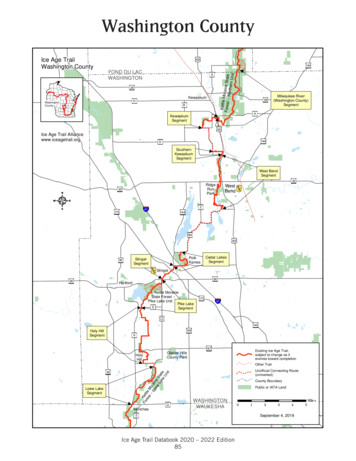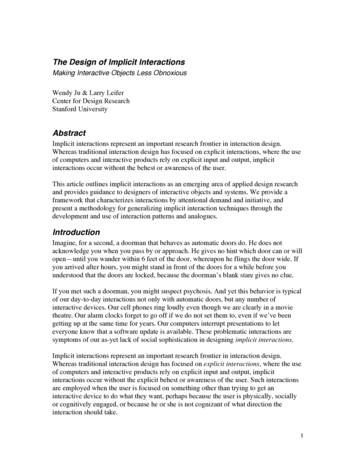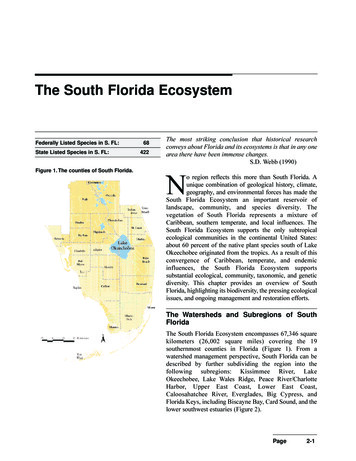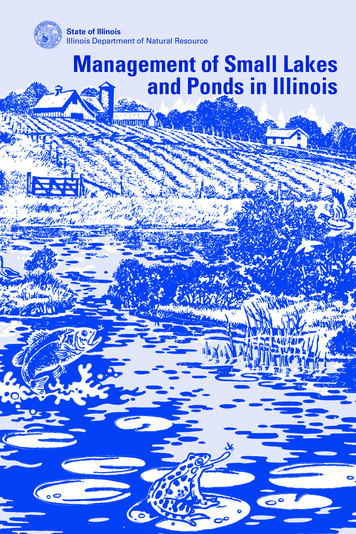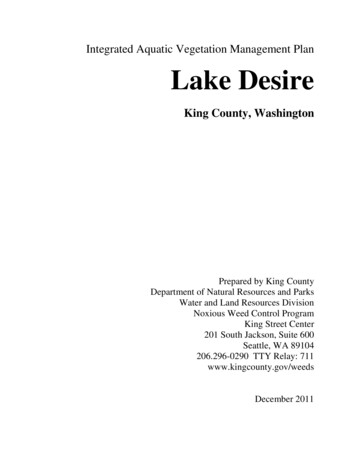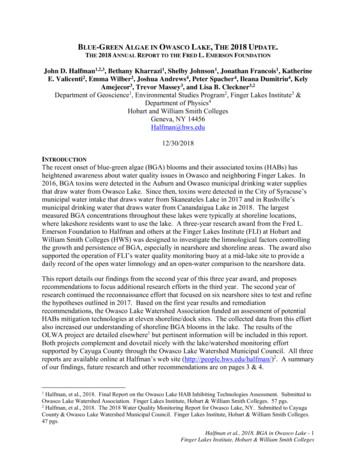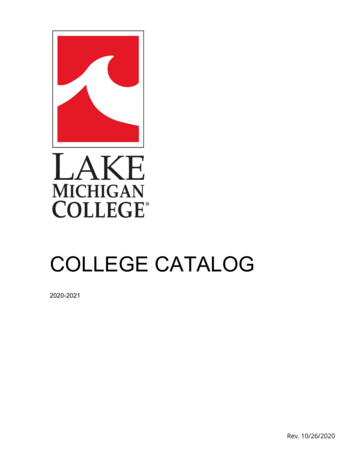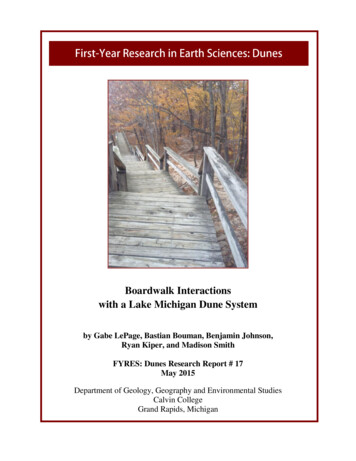
Transcription
Boardwalk Interactionswith a Lake Michigan Dune Systemby Gabe LePage, Bastian Bouman, Benjamin Johnson,Ryan Kiper, and Madison SmithFYRES: Dunes Research Report # 17May 2015Department of Geology, Geography and Environmental StudiesCalvin CollegeGrand Rapids, Michigan
ABSTRACTBoardwalks enable visitors to enjoy dunes in a way that protects sensitive duneenvironments from human impacts, but a tension remains as a boardwalk itself alters a dunesystem. This study investigates how a boardwalk in Hoffmaster State Park, Michigan affectshuman interactions with a Lake Michigan coastal dune system. In autumn 2014, the boardwalkwas mapped and the quality of its features assessed. Human impacts were investigated bydocumenting unmanaged trails and interviewing park staff. Ecological communities weremapped, and vegetation conditions near the trails were recorded. The boardwalk is part of amanaged trail system connecting a visitor center with the beach; the boardwalk gives visitorsaccess to a high dune lookout over Lake Michigan. The boardwalk ends at two viewingplatforms and is worn but functional. A network of unmanaged trails indicate that people leavethe boardwalk. The boardwalk and the unmanaged trails interrupt the ecological communities.The study results suggest that the boardwalk enables enjoyment of the dune and protectsvulnerable environments, but it also affects the formation of unmanaged trails and influencesdune processes. Understanding the spatial patterns of human interaction with the dune caninform the planning process as park staff work towards reconstructing the boardwalk in the nextfew years.INTRODUCTIONBoardwalks provide people with experiences of fragile natural areas whilesimultaneously protecting vulnerable environments. Managers of coastal dune environmentsoften build boardwalks to preserve these fragile systems and to allow access by visitors. Theboardwalks form an infrastructure that influences how humans interact with the coastalenvironment, yet very little research has been done on this relationship.This case study of a boardwalk in a Lake Michigan dune system is guided by thequestion: How does infrastructure affect human interaction with dunes and their processes? Toanswer the question, four research objectives were pursued: To document the boardwalk and its features, To document dune characteristics, To investigate recent dune changes in the topography and ecology, and To investigate human interactions with the dune.1
BACKGROUNDThe beach and dune environments of the West Michigan coast are popular attractions forvisitors. One of the most popular areas to visit, Holland State Park, has more than 1.5 millionvisitors each year (van Dijk and Vink 2005). The tourism industry is a valuable part of theMichigan economy; in 2014, 113.4 million visitors generated 37.8 billion in total business sales(Tourism Economics 2015). Natural resources remain a key factor in drawing visitors to thestate. The Pure Michigan campaign’s 2012-2017 Michigan Tourism Strategic Plan presents thisvision: “Maintaining access to these resources, while simultaneously preserving their integrity, iscritical to their long-term sustainability and integral to conserving the quality of life that makesMichigan a great place to live and a premier travel destination” (Nicholls 2013). The challenge isnot unique to Michigan, as managers of coastal environments around the world seek to preservenatural areas while allowing public access (Carlson and Godfrey 1989).Though many use the word “preserve,” dunes are naturally changing landforms that defystatic preservation (Carlson and Godfrey 1989), as exemplified in the Lake Michigan dunes (vanDijk 2004). Lake Michigan dunes are composed of quartz sand blown from the beach inland byprevailing winds from the west (Cowles 1899; Hansen et al. 2009). Fluctuations in lake levels inthe last 6,000 years caused periods of activity and periods of stabilization and have been a mainfactor in the current condition of dune topography (Hansen et al. 2010). During low lake levels,exposed beach sand is deposited by the wind in coastal vegetation, forming foredunes (van Dijk2004). Older and taller dune ridges are inland and often well stabilized with vegetation (van Dijk2004). When the vegetation is disturbed in areas of high wind energy, blowouts occur,sometimes growing to form parabolic dunes that bury vegetation beneath them (Hansen et al.2009). The parabolic dunes travel inland, often piling up onto older dune ridges and stabilizedparabolic dunes (Olson 1958).After a blowout occurs or a slipface buries an area of vegetation, the ecological processof succession restarts. Pioneering species may colonize areas of bare sand, beginning thecomplex processes of ecological succession that may result in forest development (Cowles 1899;Olson 1958; Lichter 1998). The pioneering species are typically succeeded in order by conifers,black oaks, and mixed forest as disturbance decreases and a soil develops (Cowles 1899; Olson1958; Lichter 1998). The path of succession is variable and is dependent on topography, type ofdisturbance, sources of seed, and other factors (Figure 1; Olson 1958).2
Figure 1. Different initial conditions result in different paths of ecological succession (from Olson 1958,p. 152).Due to their parent material and dynamic nature, coastal dunes are among the mostfragile environments in regards to human trampling (Talora et al. 2007). Research shows thatexcessive human trampling will decrease plant diversity and density, compact the soils, decreaseorganic matter, and create paths (Andersen 1995; Santoro et al. 2012). Large amounts of visitorsmay also cause a notch in the dune crest and lower the dune height (van Dijk and Vink 2005).Trampling may increase sand movement and cause blowouts (Burkley et al. 2014). The impactsof trampling are dependent on the time of year, the topography, and the intensity of the trampling(Hylgaard and Liddle 1981). While a small amount of human trampling may benefit certain plantspecies which depend on disturbance, excessive human trampling in areas of early successionalstages such as bare sand or dune grasses will alter or prevent ecological succession (Andersen1995).Effective management can allow for both public enjoyment and protection of the dunesystem (Carlson and Godfrey 1989). A primary strategy is the construction of maintenancefeatures. According to Randall and Newsome (2008, p. 24), “Maintenance features areengineering or educational solutions (i.e. steps or signs) that help to counteract walk traildegradation or increase user comfort”. Maintenance features include sand fences, trails,3
boardwalks, signs, boot cleaning stations, and benches. Managed trails are pathways that areplanned and maintained by natural area managers to provide access to specific environments. Awell-managed trail can be important for limiting erosion and protecting plant communities(Randall and Newsome 2008). Because of the dynamic nature of dune environments, an effectivemanagement plan must account for and allow change (Carlson and Godfrey 1989).Boardwalks are a management technique proven to reduce human impacts on fragileenvironments (Carlson and Godfrey 1989; Randall and Newsome 2008). They are builtwalkways, usually wooden, which can be designed to allow for change in a dune environment.Leaving 3cm space between the boards and elevating the walkway at least 0.5 m above the sandcan allow sunlight through to plants and leave room for sand accumulation (Carlson and Godfrey1989). A different method, used in this case for vehicles, involves placing a ground level woodenramp which can be easily lifted and reset after sand accumulation (Carlson and Godfrey 1989).Boardwalks often provide educational information about the dunes which can increase visitorrespect for the fragility of the environment and the rules of an area (Carlson and Godfrey 1989).STUDY AREADune 4 of Hoffmaster State Park, Michiganprovides a case study for the research question. Thepark is located on the coast of Lake Michigan in northOttawa County and south Muskegon County (Figure2). Dune 4 is a system of several dunes, including alarge nested parabolic dune, a dune ridge, a foredune,and several blowouts (Figure 3). The managed trailfrom the Gillette Sand Dune Visitor Center leads to alarge blowout on the first dune ridge, the foredune, andthe beach. A branch of the managed trail system,known as the Dune Climb, leads to a boardwalk thatclimbs to the highest crest of the parabolic dune.Figure 2. Location of Hoffmaster StatePark4
CAABFigure 3. Location of Dune 4 in Hoffmaster State Park and focus areas A, B, and C.Three areas were identified for specific focus. Area A refers to the beach, foredune, andfirst dune ridge. Area B refers to the nested parabolic dune is used by the park for duneeducation. Area C refers to the largest parabolic dune east of the nested parabolic dune and is themain area of analysis.This study took place as the management of Hoffmaster State Park was planning torebuild one of their boardwalk structures within the next year, provided they receive funding(Brockwell-Tillman 2014). The current boardwalk was built in 1975 with the help of theMichigan National Guard, who used a helicopter to airlift lumber from the parking lot to the topof the dune (Brockwell-Tillman 2014). At the time of this study, the boardwalk was almost 40years old. A greater understanding of the boardwalk’s impacts on how humans interact with andaffect the dune may help guide future boardwalk designs.5
METHODSField data was collected during site visits on October 23, October 30, and November 6,2014. A variety of methods were used to meet the four research objectives.Documenting the Boardwalk and Its FeaturesTo document the boardwalk and its features, the whole managed trail system, its length,and its features were recorded using a GPS Trimble Unit. The full length of the trail systemconnecting the Visitor Center to the beach and the dune crest was mapped using lines. Polygonswere used to map viewing platforms and points were used to denote trail management featuressuch as benches and signs.Documentation of boardwalk characteristics was focused on the Dune Climb, which wasdivided into the upper wing, the lower wing, and the stairs. The quality of the boardwalk wasobserved by noting the condition of the walking area, the railing, and management features. Twoobservers separately estimated the condition of each area and category, rating it on a sliding scalebetween 0 (unusable condition) and 1 (excellent condition). The number of unmanaged trailsleading from each section of the boardwalk was recorded, and the percentage of bare sandunderneath each section was estimated. The two observers averaged their estimation of eacharea’s condition, count of unmanaged trails, and estimation of bare sand percentage.Documenting Dune CharacteristicsPhysical characteristics of the study area were documented. Dune crests, arms, blowouts,slipfaces, and dune types were identified. The height of the dune crests and the distance of eachcrest from the lake was identified using an online elevation profile application found in theMichigan Dunes Inventory GIS at http://gis.calvin.edu/MDI/ (VanHorn et al. 2014). Photos ofthe dune area were taken.Different ecological communities in Area C were mapped using a GPS Trimble Unit. Thechosen communities are a simplified version of the complex framework of ecological successionin dune environments developed by various ecologists and dune researchers (Table 1). Eachcategory was mapped as a polygon within Area C. Categories of a higher successional stagewere mapped in polygons which could include vegetation from categories of a lower6
Ecological CommunityBare sandPioneering vegetationConifersSuccessional StagePre-successionFirst stageSecond StageExamples of SpeciesNone presentAmmophila breviligulata (American beach grass)Pinus strobus (white pine), Pinus banksiana (jackpines)Black oak forestClimaxQuercus velutina (black oaks)Mixed forestClimaxFagus (beech), Tsuga (hemlock), Sassafras(sassafras), Acer (maple)Table 1 Categories for classifying ecological communities in the study area. Categories are based onwork by Cowles (1899), Olson (1958) and Lichter (1998).successional stage. In areas A and B, types of ecological communities were observed but notmapped.Identifying Recent Changes in the Topography and EcologyChanges in dune activity over the last century were recorded using aerial imagery datingback to 1938. Aerial images of Dune 4 from 1938, 1950, 1955, 1968, 1974, 1981, 1988, and1996 (Appendix A) were studied to see if any major changes in form or land cover haveoccurred. Alterations in topography such as blowout and nested parabolic dune locations and thechanges in land cover were recorded to understand if the topography of the dune was changing orstabilizing. Significant changes in vegetation were recorded according the ecological frameworkdescribed above.Each aerial photo was analyzed according to a standardized classification of dune activityknown as the Dune Features Inventory (DFI) Activity Classification (Table 2; Appendix B). Theentire Dune 4 was analyzed together using a series of 5 yes or no questions (Appendix B). Thequestions determine whether the dune is stable and entirely vegetated, very active with largeareas of bare sand and early colonizers, or somewhere in between.Activity ClassificationInactive (Stable)Slightly ActiveModerately ActiveActiveVery ActiveKey DescriptorDune is almost 100% vegetatedOne or more active blowouts are present on the duneSubstantial dune activity (blowouts) but dune is not advancingDune is advancingDune is advancing quickly (e.g., 1 m/year or more)Table 2. Summary of Dune Features Inventory activity classes (see Appendix B for more detail).7
Investigating Human Interaction with the DuneTo understand the human impact on Dune 4, unmanaged trails in the study area weremapped. Unmanaged trails were identified as linear breaks in the vegetation and ground cover orlines of trampled vegetation which signify human traffic. Trails were mapped as segmentsbetween intersections and numbered in the order they were recorded. For each segment, theamount of litter, a short description of vegetation and ground cover, and comments wererecorded.Direct reporting of how humans interact with the dune environment was obtained using aquestionnaire and an informal interview with park naturalist, Elizabeth Brockwell-Tillman. Thequestionnaire was a single, 2-sided sheet of paper asking questions about perceptions ofmanagement practices and activities engaged when visiting the park (Appendix C). Copies of thequestionnaire were placed in the Visitor Center for a period of two weeks with a sign invitingvisitors to participate. A “ballot box” enabled visitors to return the completed questionnairequickly and confidentially. Researchers also carried copies while at the study site and askedpeople encountered to participate. Brockwell-Tillman visited the study site with the researcherson October 30 where she answered prepared questions and discussed her experience of the studyarea.RESULTSBoardwalk and Managed TrailThe managed trail system is 0.85 km long including all segments (Figure 4). The trail isdesigned to allow visitors to move between the Visitor Center, the beach, and the two viewingplatforms and to safely enjoy the space in between (Figure 5). The Dune Climb, the section oftrail leading to the highest crest of Dune 4, has a steep section of stairs and comes to twoendpoints at the viewing platforms.8
Figure 4. Managed trail system and locations of management features.Figure 5. (A) Boardwalk on the dune crest. (B) Southern viewing platform.9
The managed trail system is made upof a mix of raised boardwalk and othermanaged trail sections. Trail sections havesurfaces of earth, sand, or gravel, and theyoften have railings and wooden supports tocreate steps or to stabilize slopes beside thetrail. The raised boardwalk is a metal orwooden platform raised above the surface ofthe dune or the backdune area. The metalsection is near the Visitor Center (Figure 6)Figure 6. Metal section of the boardwalk.while the rest of the boardwalk is wooden.The boardwalk typically has railings and is elevated above dune surface. Spaces between theboards are less than 3cm.Management features include benches, signs, and a boot cleaning station. The benchesare most concentrated on the steep section of stairs leading to the dune crest, but a bench is alsofound on the highest viewing platform. Signs are both informational and cautionary. Theyprovide facts about the dune environment, warnings of hazards to visitors, and warnings againstleaving the trail (Figure 7). Some signs are weathered and in need of replacement. A bootFigure 7. (A) The stairs which lead to the highest crest of Dune 4 on the leeslope of the parabolic dune.(B) An informative sign at the southern viewing platform in need of replacement. (C) Some of the hazardsof the backdune forest.10
cleaning station provides a place at the entrance to the Dune Climb for visitors to scrub theirshoes to prevent the spread of invasive species.Forty years after its construction in 1975, the boardwalk is showing signs of wear. Inparticular, the upper portion of the stairs shows evidence of being moved by the pressure of sandpiling at the dune crest. Yet, the boardwalk is functional. The condition of both wings and thestairs as estimated between 1 and 0 can be seen in Table 3. The railings are stable but do not stopvisitors from climbing off the boardwalk and forming unmanaged trails. Very little space existsbetween the boards of the boardwalk, allowing little light beneath and less vegetation to grow.The slope beneath the stairs shows signs of erosion.QuestionBoardwalk SectionUpper Wing Lower WingStairsCondition of Walking Area?0.830.630.60Condition of Railing?0.750.600.70Condition of Misc.?0.600.800.55# of Unmanaged Trails3.004.500.00% Bare Sand48%78%90%Table 3. Classification of conditions for different boardwalk sections, as averaged from estimates by tworesearchers. Conditions closer to 1 are excellent while conditions closer to 0 are unusable.Dune CharacteristicsDune 4 is a parabolic dune system involving several parabolic dunes, a dune ridge,blowouts and a foredune. The elevations above lake level and distances from the water of thedune crests are shown in Table 4. In Area A, there is a foredune and a dune ridge with a largeblowout. Area B consists of a nested parabolic dune and Area C includes the upper windwardslope and crest of the largest parabolic dune of the system. Sand movement is evident indepositional lobes downwind from blowouts.Dune Crests:ForeduneArea AArea BArea CElevation above Lake Level (m)5m7m23m57mDistance from Water (km)0.05km0.1km0.2km0.5kmTable 4. Elevations above Lake Michigan and distances from shoreline for dune crests in different Dune 4areas. Elevations and distances were calculated using the Elevation Profile Application in the MDI GIS(VanHorn et al. 2014). Dune crests increase in height with distance from the shore making for excellentviews from the viewing platform in Area C.11
Figure 8. The ecological communities in Area C of Dune 4.Dune 4 exhibits each of the main ecological successional stages known for WestMichigan dunes, from bare sand blowouts to well-developed mixed forest (Figure 8). In Area C,blowouts are found towards the middle of the windward slope, about halfway between the topand the bottom. Between the blowouts and on the upper windward slope, pioneering vegetationdominates, especially Ammophila breviligulata (American beach grass.) Conifer species arefound mostly on the lower windward slope but also at the crest of the dune. Pioneering speciescover the ground between the conifer trees in both areas. Areas of predominantly black oak(Quercus velutina) forest are found at the bottom of the windward slope and along the north andsouth dune arms. On the south side of the upper windward slope, the black oak forest protrudesinto the area of pioneering vegetation, separated by an unmanaged trail and an area of pioneeringvegetation. On the north arm, black oak forest is found on the north side of the boardwalk, exceptfor a few younger trees growing south of it. Conifers can be found within the black oak forestareas, especially in the southwest of Area C. A patch of young beech trees, indicative of a mixed12
forest, can be found on the southern arm of the dune and a single young beech tree is growing onthe north arm just south of the boardwalk on the upper windward slope. Beyond the crest andarms of the dune and surrounding the black oak forest on the lower windward slope is mixedforest, including hemlocks, beech, sassafras, and maples.Area B has a much larger blowout on the upper windward slope of the nested parabolicdune with pioneering vegetation and conifers on the lower windward slope. The nested parabolicdune is also surrounded by mixed forest on the crest and the outside of its arms. Area A has alarge blowout where the managed trail ends at the edge of the forest that extends all the way tothe beach. Outside of the disturbed area is pioneering vegetation, including cottonwood trees.Recent Changes in the Topography and EcologyAir photo analysis shows that since 1938, the overall activity level of Dune 4 has changedvery little (Table 4). Over the last 77 years, Dune 4 has never been entirely vegetated. Activeblowouts have been present and substantial areas of the dune have been active. The aerialphotographs provide no evidence that the dune has been advancing, though forest cover makesthis difficult to assess. The photos also show that higher levels of ecologic succession than justbare sand and early colonizers cover parts of the dune surface. According to the Dune FeaturesInventory, Dune 4 is Moderately Active and has been for some time.Though the activity level has stayed constant, internal changes to the dune have beensignificant. Since 1938, forest has pressed in on the edges of the dune, especially on the arms andcrest of Area C. Black oak forest has developed on the north arm and the southeast corner of thestudy area where it had not been before. The lower windward slope of the Area C also developedYear of Air Photo19381950195519681974Activity ClassificationModerately ActiveModerately ActiveModerately ActiveModerately ActiveModerately Active198119881996Moderately ActiveModerately ActiveModerately ActiveComments:Evidence of slipfaceSlipface is half the sizeSlipface is forestedMid-slope vegetation disappearedDune C’s windward slope appearsvegetated. Dune A is bare sand.Table 4. Activity classification of Dune 4 from air photos (1938-1996).13
a black oak forest where there had not been one before. The black oak forests are first noticeablein the 1981 photograph, which is the first photograph available after the boardwalk wasconstructed in 1975. Looking at the differences between the aerial photograph from 1968 and therecent Esri imagery, the nested parabolic dune in Area B has visibly moved eastward (Figure 9).On-site observations in 2014 reveal that the slipface is piling up on the forest which hasdeveloped there in the 30 years. Since 1968, the blowouts in the middle of the windward slopeFigure 9. With 1968 imagery on the left and recent Esri imagery on the right, the appearance of theboardwalk and changes in topography and vegetation are clear to see. The nested parabolic dune hasvisibly shifted during this period. The amount of vegetation and blowout activity in Area C has alsochanged significantly, possibly due to the boardwalk.14
have moved east and been chased by the forest. There is visual evidence that human traffic fromthe managed trail has maintained and widened the blowout in Area A.Human Interaction with the DuneA network of unmanaged trails is present on Dune 4, connecting the boardwalk to thebeach (Figure 10). The viewing platforms and sections of the boardwalk that are easier to climbover serve as end points for the trails. The trails either follow the arms of the dune between thecrest, the beach, and a hidden lookout point on Dune 3.5, or the trails connect to a central trail,which joins the bottom windward slope of Area C and the beach via the nested parabolic dune.State park naturalist Elizabeth Brockwell-Tillman shared some anecdotal evidence abouthow some unmanaged trails have developed. One cause has been park culture. Some parkvolunteers and regular visitors have made it a habit to take weekly dune ridge walks for manyyears now. Another cause is individual visitor activities. In 2014, Brockwell Tillman observed aFigure 10. The unmanaged trail complex in relation to the managed trail system.15
person regularly coming to the park toplay fetch with a dog. BrockwellTillman notes that the prominent trailconnecting the central viewing platformto the blowouts did not exist before thisvisitor’s activity (Figure 11).Public response to thequestionnaire about human activity waslimited. We received 5 completedquestionnaires over the period of twoweeks. 100% percent of those surveyedwrote that when they come to the dunethey use the boardwalks and managedtrails to enjoy scenery at the dune and40% wrote they go to the dune to rundown it. The last question showed that“access to scenic views,” “make it easierto climb dune,” “provides exerciseFigure 11. Unmanaged trail reportedly caused by dogopportunities,” “protect dune vegetation/wildlife,” and “increase enjoyment of dune” were 100%valuable to the 4 survey takers who answered this question. 60% of those surveyed have been tothe dune many times. All people who took the survey were from west Michigan.Other than the trails themselves, observable human impacts to the dune area were limited.The trails did affect the topography and ecology of the dune area, sometimes causing indents inthe surface (up to 1 meter deep in one case) and creating areas of bare sand. Not much litter wasleft on the dune at the time of research; 15 pieces were found over the whole area. No signs ofcamping such as campfires were evident.16
DISCUSSIONThe park’s built infrastructure influences the development of the unmanaged trail systemand the processes of sand transport and ecological succession. Our results suggest several ofthese relationships warrant more attention: how the managed and unmanaged trail systems andthe dune topography interact, how park culture can influence human impacts, and how the trailcomplex affects ecological succession.Unmanaged Trails, Boardwalk, Topography, and Visitor ChoiceThe unmanaged trail system is a product of three influences: people’s behavior, the dunetopography, and the boardwalk. On one level, the unmanaged trail system is shaped primarily bythe whims of human visitors to the park—where they want to walk is where trampling will occurand trails will form (Hyldaard and Liddle 1981; Talora et al. 2007). Typically, visitors seek easeof access and points of interest. However, the natural topography and human infrastructure alsoplay distinct roles in determining where people want to walk.The boardwalk connects to the unmanaged trail system in a number of ways. Theboardwalk structure provides the easiest access to the dune crest and the best views and seatingareas. It directs visitor traffic and reduces human impacts on the dune (Carlson and Godfrey1989; Randall and Newsome 2008). Yet as visitors walk on the boardwalk, points where onemay climb off the infrastructure with ease provide starting points for unmanaged trails. Thevisitors may be seeking to access points of interest that cannot be reached by the managed trailsystem. Boardwalk end points also serve as these starting points for unmanaged trails. Benchesand viewing platforms with excellent views may serve as points of interest in themselves(Carlson and Godfrey 1989). If visitors find it easier to reach them from a location off themanaged trail system, they may do so and create unmanaged trails. As a result, decisions ofboardwalk design are crucial for determining how much and where humans impact the duneenvironment.The dune topography also plays a critical role in shaping human impacts. The tendencyof visitors to dune environments is to seek high points, good views, and places to walk (Arevaloet al. 2013). The dune arms provide the most stable and most gently-sloped ways to get to andfrom the beach and the dune crests, but the dune arms are also mostly hidden behind trees. Themost visible unmanaged trail follows the center of Dune 4 connecting the beach, the crest of the17
first dune ridge, the crest of the nested parabolic dune, and the lower windward slope of Area C.From there, the unmanaged trail splits in many directions directly to and from the points ofinterest on the dune crest and the boardwalk. The unmanaged trail along the north arm connectsthe northern viewing platform to where the managed trail from the visitor center exits onto thedune. The trail on the south arm leads from the southern viewing platform to a lookout on Dune3.5 and an unstudied system of unmanaged trails. Visibility of the trails and their accessibilityare a factor in their use.Park Culture and Unmanaged TrailsKey to the creation and use of unmanaged trails is the human culture of the visitors andthe park. Visitor decisions about whether to leave the boardwalk or not can be influenced bytheir understanding of how trampling affects dune vegetation and sand transport (Carlson andGodfrey 1989). Park rules, their enforcement, the possibility of punishment, and the amount ofinformation provided by the park are critical factors as well. If park volunteers provide examplesof leaving managed trails, rules do not exist, or rules are not known, then the creation ofunmanaged trails is more likely.Trail Complex and EcologyThe spatial layout of the managed and unmanaged trail sy
Location of Dune 4 in Hoffmaster State Park and focus areas A, B, and C. Three areas were identified for specific focus. Area A refers to the beach, foredune, and first dune ridge. Area B refers to the nested parabolic dune is used by the park for dune education. Area C refers to the largest parabolic dune east of the nested parabolic dune and .

